December 2019
By Paul F. Walker
As states-parties to the Chemical Weapons Convention (CWC) convened for their 24th and most recent conference in November in The Hague, it was clear the treaty has accomplished a great deal, but it was also apparent that the work of eliminating the threat of chemical weapons is not over.
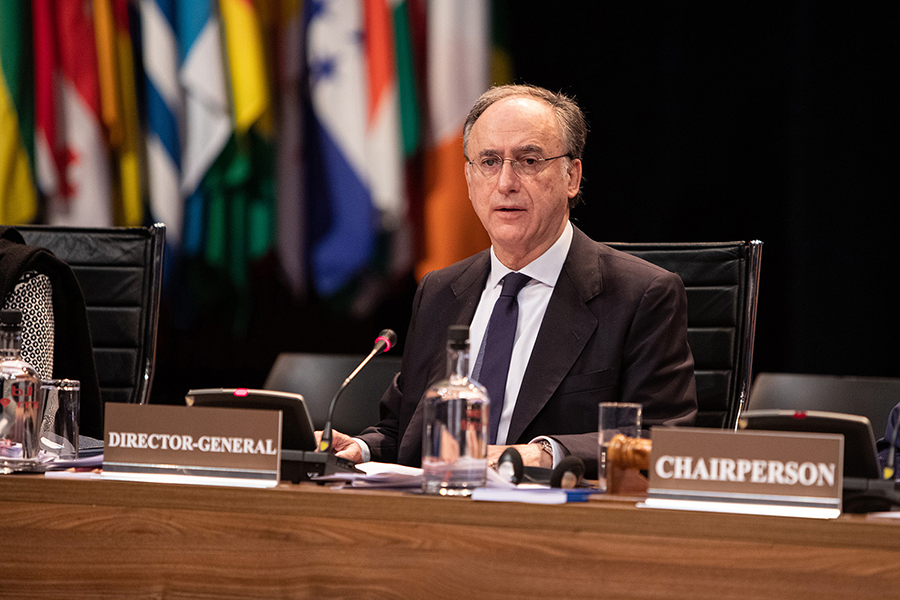 As the head of the Organisation for the Prohibition of Nuclear Weapons (OPCW), Fernando Arias, noted in his opening statement, “The complete elimination of declared chemical weapons, which is a key goal of the convention, is nearing. Yet, challenges to the norms of the convention are serious, as the use of chemical weapons in Iraq, Malaysia, Syria, and the United Kingdom has proven.”1
As the head of the Organisation for the Prohibition of Nuclear Weapons (OPCW), Fernando Arias, noted in his opening statement, “The complete elimination of declared chemical weapons, which is a key goal of the convention, is nearing. Yet, challenges to the norms of the convention are serious, as the use of chemical weapons in Iraq, Malaysia, Syria, and the United Kingdom has proven.”1
Even as the final declared stockpiles of banned chemical agents are destroyed and work continues to bring the few remaining holdout states into compliance with the treaty, in the years ahead the OPCW will remain the main line of defense against the reemergence of chemical weapons.
Origins
The struggle to eliminate the threat of chemical weapons is long and began well before the CWC entered into force in 1997 and the OPCW began overseeing proscribed chemical weapons destruction activities by states-parties across the globe.
The United States and Soviet Union, the two largest possessors of chemical weapons during the Cold War, agreed in the late 1980s in bilateral negotiations to eliminate their sizeable stockpiles. The Soviet Union had 40,000 metric tons of deadly chemical agents in seven large stockpiles, six of which were west of the Ural Mountains and one just east. The United States had nine top-secret stockpiles holding 28,600 metric tons of chemical agents spread around the United States from Maryland to Oregon, with one stockpile on Johnston Atoll in the Pacific Ocean.
Both superpowers came to recognize that these aging yet still deadly arsenals were no longer militarily relevant, let alone practical to use on the battlefield. In fact, most launch systems for these weapons of mass destruction were no longer available, and the weapons themselves—spray tanks, aerial bombs, land mines, artillery shells, rockets, and missile warheads—were corroding, leaking, and very dangerous for troops
to handle.
This bilateral effort to eliminate a whole class of weapons of mass destruction was partially driven by ongoing multilateral negotiations in the Conference on Disarmament (CD) in Geneva since the early 1970s, as well as by the horror of indiscriminate chemical weapons attacks by Saddam Hussein against the Kurds in northern Iraq in 1988, killing more than 5,000 innocent Iraqi civilians, and thousands more throughout the eight-year Iran-Iraq war of the 1980s. Even today, more than three decades since these attacks in Iran and Iraq, many victims continue to suffer with long-term health impacts, and the CWC recognizes this very sad legacy of warfare with a memorial and a support fund in The Hague.
Chemical weapons have been widely condemned by many countries over the last century, especially after the major use of chlorine, mustard, phosgene, and other deadly chemicals in World War I. Although most soldiers were injured and killed with conventional weapons, historians estimate that some 90,000 soldiers were killed by chemical agents in this war, starting in 1915 with Germany’s massive chlorine gas attack at Ieper, Belgium. The Geneva Convention in 1925 banned the use of chemicals in warfare, but failed to ban the development, testing, and production of chemical weapons.2
Fortunately, the CWC was finally concluded in the CD and opened for signature in January 1993. More than a hundred countries, including the United States and Russia, signed the CWC in early 1993, and it entered into force on April 29, 1997, after 65 countries had ratified it. After a long political battle, the U.S. Senate ratified the CWC in April 1997, and Russia followed suit in December 1997.
The CWC bans all chemical weapons, including their development, testing, production, stockpiling, and use in warfare, and requires all existing stockpiles to be safely destroyed within certain specified time frames.3 The United States and Russia were required to eliminate their enormous stockpiles by April 29, 2007, 10 years after entry into force, with an option of up to five years of extension until 2012. This length of time was thought by negotiators to be more than sufficient to allow countries with declared chemical weapons stockpiles to carefully eliminate their arsenals. The CWC also bans the dumping of chemical weapons at sea or in any body of water, burying them on land, or open-burning them, all common practices until the 1970s and perhaps even later.
Chemical Weapons Demilitarization
The United States
CWC negotiators grossly underestimated the complexity and cost of safely destroying the large and aging stockpiles of chemical agents that were declared by eight countries when they joined the convention. The early plan of the United States was to construct three large, centralized incinerators—one on Johnston Atoll; one in Tooele, Utah; and one in Alabama or Arkansas—and transport the weapons from the other six stockpiles across thousands of miles to these sites for ultimate disposition. Fortunately, the U.S. Congress banned transportation across state lines, requiring the Department of Defense to produce a second strategy for destruction that would require nine individual incinerators, one at each declared stockpile.4
Yet, the U.S. Program Manager for Chemical Demilitarization (PMCD), located in Aberdeen, Maryland, had underestimated public concern about burning deadly chemical agents and any possible atmospheric toxic pollutants that might result from this process. By the early 1990s, when the first prototype U.S. incinerator was constructed and began operating on Johnston Atoll, questions began to be raised about what environmental controls and regulations would be in place to prevent any release of toxic pollutants and live agent. Although these high-tech incinerators included the most modern wet and dry scrubbing technology and PMCD representatives alleged that no serious releases would be allowed, the Johnston Atoll incinerator operators found small amounts of live agent released from the smokestack, as well as a heavy metal, mercury, that no one had predicted would be found.
Citizen activists from all chemical weapons stockpile communities organized into a grassroots organization, the Chemical Weapons Working Group, led by Craig Williams, an ex-Marine Corps Vietnam veteran from Kentucky, and advocated for technologies other than incineration. The Armed Services committees in Congress warned that some communities might not accept incineration as the optimal weapons destruction technology and the Army should consider technical alternatives to incineration. Finally, Congress legislated a national dialogue effort, the Assembled Chemical Weapons Assessment program, to demonstrate nonincineration options for communities and that met for more than five years to develop more manageable and acceptable technologies for destroying deadly chemical agents and explosives, propellants, metal parts, and related contaminated materials, such as wood, fiberglass, and plastics.
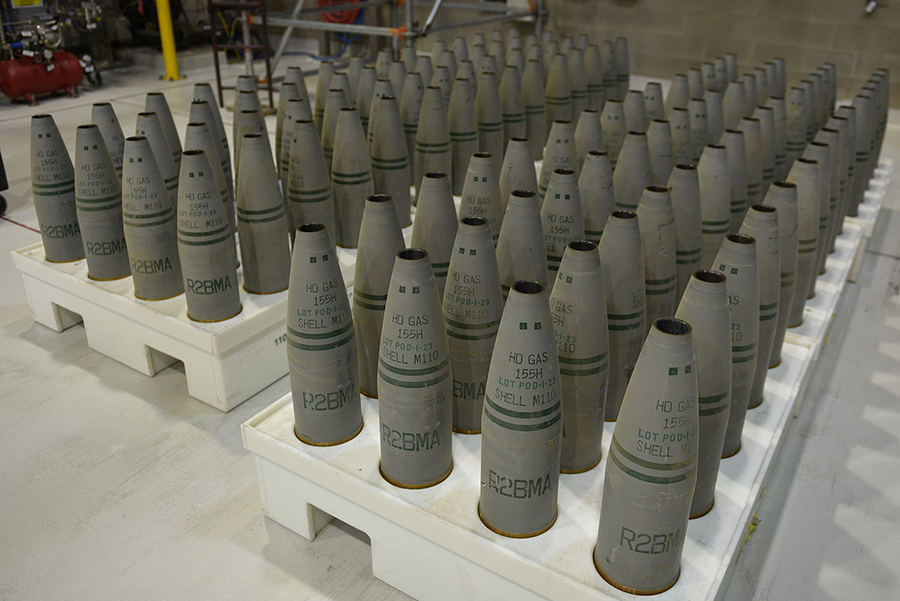 By the early 2000s, the ACWA Dialogue, including representatives from the Army, governors’ offices, and industry, along with grassroots activists, public health experts, and other interested stakeholders, recommended a wet chemistry option: neutralization, followed by bioremediation, supercritical water oxidation, and other technological processes.
By the early 2000s, the ACWA Dialogue, including representatives from the Army, governors’ offices, and industry, along with grassroots activists, public health experts, and other interested stakeholders, recommended a wet chemistry option: neutralization, followed by bioremediation, supercritical water oxidation, and other technological processes.
Ironically, France had been using neutralization—mixing chemical agents with hot water and a caustic reagent—for years to effectively destroy buried chemical weapons from the world wars. In the end, four of nine U.S. stockpiles chose neutralization, while five used incineration, partly because incinerators had already been built at their sites.
The United States began operating its first incinerator on Johnston Atoll in 1990, seven years before the CWC entered into force. Over the next decade, the United States burned 1,842 metric tons of mustard agent in weapons secretly removed from Okinawa and Germany in earlier years. The second U.S. stockpile to be destroyed was in Tooele, Utah, which held 12,303 metric tons and had begun incinerator operations a few years later.
Today, the United States has safely destroyed more than 93 percent of its declared stockpile of chemical weapons through incineration or]neutralization as first-stage destruction processes. Seven of nine stockpiles have been fully destroyed, while the mustard agent stockpile in Pueblo, Colorado, has now been 42 percent destroyed since start-up in 2018. The second remaining stockpile at Blue Grass, Kentucky, where operations just partly started 2019, has been about 2.3 perecent destroyed. The United States has projected that its chemical weapons stockpiles will be totally destroyed by the end of 2023, four years from now.5
The Russian Federation
In signing and ratifying the CWC, Russia declared seven large chemical weapons stockpiles holding 40,000 metric tons of agent, much of this in bulk form in storage tanks. Two stockpile sites at Shchuch’ye, the easternmost site in the Kurgan Oblast along the Kazakhstan border, and another at Kizner in the Udmurt Republic, held 5,457 and 5,745 metric tons, respectively, of nerve agents in millions of weapons, largely artillery shells and missile warheads.6
A U.S. on-site inspection of the Shchuch’ye stockpile in July 1994 revealed that physical security at these sites was minimal at best and that there was no accurate accounting or inventory of the weapons.7 This was a major concern of the United States and allies who worried that the artillery weapons might easily be stolen and proliferated to subnational groups. U.S. Senator Richard Lugar (R-Ind.) made this concern public when he was photographed at Shchuch’ye pretending to place a chemical artillery shell in a briefcase.
After a decade of international discussions and proposals, the U.S. Cooperative Threat Reduction (CTR) program committed $20 million in the early 2000s to upgrading security at both sites. Shchuch’ye and Kizner received new fencing, guard towers, lighting, video and electronic surveillance, and troop training. This was a major step forward for nonproliferation, as was the inventory and accounting work done by OPCW inspectors in the late 1990s after the treaty entered into force.
Russia was fully committed to safely eliminating its chemical weapons stockpile, which was the largest in the world, but had few resources in the 1990s to do so and was not knowledgeable about technical alternatives. When a senior U.S. Defense Department official offered to build an incinerator at Shchuch’ye during the 1994 on-site visit, Russian military officials and Duma members quickly refused, noting the controversial nature of incineration regarding atmospheric emissions, and responded that they wanted to determine applicable technologies after a full evaluation of Russian industrial options.
After a Russian-U.S. joint evaluation study in the mid-1990s, Russia chose neutralization as the primary first-stage destruction technology for its seven stockpile sites and moved forward with construction of demilitarization facilities at all sites, funding largely provided by the U.S. CTR program along with a number of donations from Canada, Germany, and the United Kingdom and eventually more than 20 countries as members of the 2002 Global Partnership Against the Spread of Weapons and Materials of Mass Destruction.8
The first Russian demilitarization facility opened in 2002 at Gorny in the Saratov Oblast. The stockpile held 1,145 metric tons of mustard agent, and the neutralization facility was designed and produced by the German company Eisenmann. This was a prototype neutralization process that would be replicated a few years later at Kambarka in the Udmurt Republic, where another 6,349 metric tons of mustard was stored in bulk.
The CWC mandates four progressive benchmarks for destroying chemical weapons stockpiles—1, 20, 45, and 100 percent—and Russia, because of its late start in demilitarization, 12 years after the United States began operating its first prototype incinerator on Johnston Atoll, was given formal extensions by the CWC states-parties.
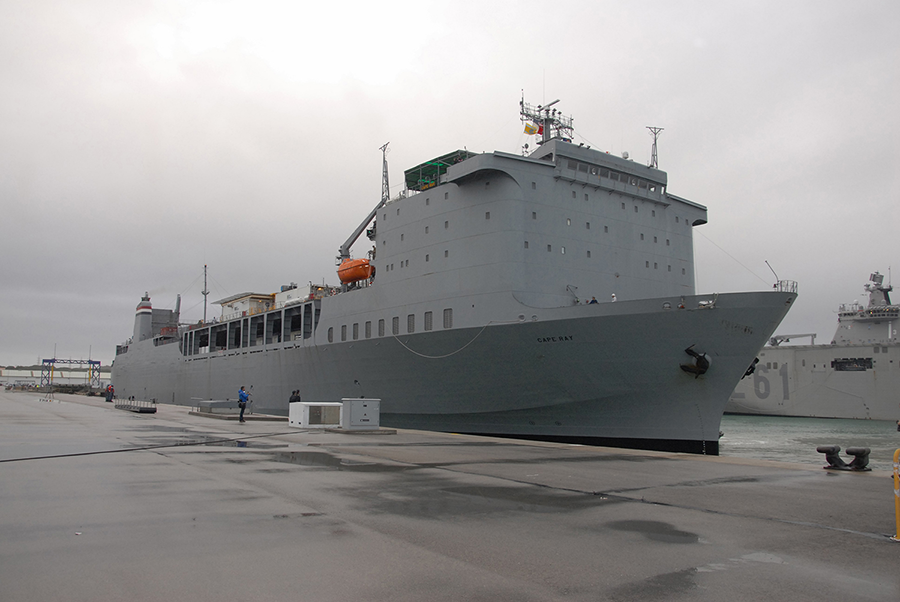 The United States, in comparison, met its first two CWC benchmarks, primarily because of its early unilateral start, but also needed extensions under the CWC for its last two. The United States and Russia missed their final deadline of 2007 and the five-year extension, to 2012, but were given support by CWC states-parties for continuing with their best efforts beyond 2012.9
The United States, in comparison, met its first two CWC benchmarks, primarily because of its early unilateral start, but also needed extensions under the CWC for its last two. The United States and Russia missed their final deadline of 2007 and the five-year extension, to 2012, but were given support by CWC states-parties for continuing with their best efforts beyond 2012.9
Russia had destroyed 50 percent of its declared stockpile by mid-2011 and announced its completion of the first-stage neutralization process, destroying all declared chemical agents, in October 2017, five years after the 2012 deadline for complete destruction. Yet, the neutralization process left tens of thousands of tons of toxic liquid, some of which still awaits final treatment. Russia was incinerating some of this liquid at sites and had decided to solidify the liquid produced at Shchuch’ye with bitumen and store it in sealed, retrievable bunkers, planning to treat the neutralized mustard agent at Gorny and Kambarka in order to retrieve arsenic for later industrial use.
This was a major accomplishment for Russia and the OPCW, achieved partly due to $2-3 billion in foreign funding from the U.S. CTR program and the Global Partnership. On-site and national facilitation and public outreach was led by by Green Cross International, an independent, nonprofit environmental group, and its Russian national affiliate, Green Cross Russia. Much credit must also go to the dedicated OPCW inspectors who worked on-site at every chemical weapons stockpile site to verify that every kilogram and every weapon was indeed destroyed permanently and safely.
Other Possessor States
The 16 declared chemical weapons stockpiles of the United States and Russia accounted for 68,600 metric tons of chemical agent, about 94 percent of declared agents in eight countries.10 The remaining six declared possessor states—Albania, India, Iraq, Libya, South Korea, and Syria—completed their destruction programs by 2009 or, in the case of Syria, by 2015.
Albania. The government in Tirana joined the CWC in 1997 but did not declare any chemical weapons stockpile. A decade later, the Albanian government came to the OPCW and asked for help in evaluating the contents of a small garage in the mountains outside of Tirana, which appeared to be chemical agent. With the support of the OPCW and national experts, the OPCW determined that Albania held several tons of mustard agent in storage containers marked with Chinese characters. Albania’s status in the OPCW was therefore changed to that of a possessor state, with no penalty, and work went forward to determine how best to safely destroy the relatively small stockpile of 16 tons of mustard agent.
Albania applied to the Global Partnership and the U.S. CTR program for help in securing and destroying its stockpile. By 2007 a small incinerator, provided by Eisenmann, had been constructed next to the garage. Yet, when this incinerator began operating in the spring of 2007, just a few weeks prior to the April 29, 2007, CWC deadline for 100 percent destruction, the first barrel of mustard agent exploded in the furnace, burned a hole in the floor, and destroyed the afterburner. Fortunately, no workers were killed, but it took weeks to repair the equipment and recalibrate the furnace, thereby causing Albania to be the first declared possessor state to formally miss its CWC deadline.
CWC state-parties understood that this possible deadline violation was not the fault of Albania and allowed it to continue its process. By July 2007, the stockpile had been fully burned, making Albania the first state to complete its chemical weapons destruction process.
Reportedly, the destruction process did not include any second-stage step for taking care of the toxic debris remaining from the incineration. This oversight would later come to haunt the United States and the OPCW when they inquired in 2014 about possibly using Albanian territory to help destroy Syrian declared chemical agents removed from Syria. Albania refused to help with Syria, pointing to the unfinished process from seven years earlier.
The Republic of Korea. The government in Seoul declared about 600 metric tons of chemical agents when it joined the CWC in 1997. The exact number of tons, as well as the specific chemical agents, types of munitions, stockpile locations, and destruction process are not publicly known due to the secrecy that South Korea requested of the OPCW. South Korea is identified in OPCW documents as “another State Party” or “a State Party,” but the OPCW inspectorate confirmed safe and full destruction of the South Korean stockpile in 2008.11
One might speculate that South Korea is sensitive about this subject due to domestic politics, recognizing that North Korea has a large chemical weapons stockpile and has refused to join the CWC. It may also be sensitive due to news reports that its stockpile was a modern binary stockpile, not dissimilar to that of the newest chemical weapons in the U.S. stockpile, possibly implicating the United States in transferring technology or weapons to South Korea over the final decade of the Cold War.
India. When it joined the CWC in 1996, India declared more than 1,000 metric tons of chemical agents. Although it has not been forthcoming in any public details about its chemical weapons stockpiles, it allows its name to be used as a former possessor state-party in OPCW documents. It is also known that it incinerated its stockpiles and completed its process in 2009. No public outreach and information was part of the demilitarization process due to the “litigious nature of Indian society” and to “potential legal delays which would interfere with CWC deadlines.”12
Although there is full confidence in OPCW inspector reports about the safe and permanent destruction of the South Korean and Indian declared stockpiles, it would be a very positive step forward when both countries are more transparent with their CWC declarations and details about their destruction processes. These are all success stories for the global abolition of chemical weapons and deserve more openness and clarity.
Libya. In 2004, Libya joined the CWC and declared 21 metric tons of chemical agents, all in storage tanks. With the technical and financial support of the Global Partnership, Libya neutralized these agents and finished its destruction program by 2014, fully verified by OPCW inspectors. Its 2007 final CWC deadline was officially extended in 2011 to 2012 for these Category 1 chemical agents.13 Along the way, after the demise of the Gaddafi government in 2011, Libya declared another secret stockpile of about 500 artillery shells, which had been hidden by the prior leadership. This was included in its destruction process and increased its declared stockpile inventory to about 26 metric tons. Since 2014, precursor chemicals—Category 2 and 3 chemicals—have been in the process of neutralization.
Syria. In the midst of a raging civil war and shortly after the large-scale use of sarin in August 2013, which killed some 1,400 civilians, Syria joined the CWC. Under pressure from the United States and Russia, the Assad regime joined the treaty, declared its chemical weapons holdings, and allowed for a complex, multinational chemical weapons removal operation led by the OPCW and the United Nations.
Syria declared 1,308 metric tons of mustard agent and chemical precursors in its first declaration to the OPCW and agreed to ship most of these chemicals through the port of Latakia onboard foreign ships for eventual neutralization and incineration. About 50 percent of these chemicals were neutralized onboard a U.S. ship, the Cape Ray, in the Mediterranean. Other parts were delivered by ship to Germany, the UK, Finland, and the United States for incineration.14 All of these countries deserve much credit and appreciation for helping Syria and Libya in in-country and out-of-country processes to safely and verifiably destroy their declared chemical weapons stockpiles.
There have been innumerable allegations of use of chemical weapons in Syria since 2012, before and after Syria’s joining the CWC. Because of these major challenges to the convention’s integrity, OPCW Director-General Ahmet Üzümcü established a Fact-Finding Mission in 2014 to seek to verify whether chemical agents had been used in Syria. This mandate did not include determining who perpetrated such CWC violations.
Üzümcü established a Declaration Assessment Team at the same time to follow up with Syria’s initial declaration, which included numerous omissions. In 2015, a Joint Investigative Mechanism (JIM) was established by the UN and OPCW to follow up on reports by the Fact-Finding Mission about chemical weapons use in order to identify which country or nonstate actor launched these attacks.
The Fact-Finding Mission conducted many on-site inspections of alleged chemical weapons attacks in Syria and found sarin nerve agent, mustard agent, and chlorine used in a number of attacks. These investigations continue today. The JIM, in follow-up to the Fact-Finding Mission reports, has reported that evidence shows that the Syrian military has been guilty of a number of nerve agent and chlorine attacks, the latter typically via helicopter-dropped barrel bombs. The JIM has also found that the Islamic State group has undertaken several attacks with mustard agent, typically with artillery shells. Several incidents offer insufficient evidence to determine with confidence that chemical agents were used and who may have undertaken the attacks.15
A recent study alleges that 336 attacks have taken place with chemical agents in Syria since 2012.16 Regardless of this figure’s accuracy or the party responsible for these attacks, this major challenge to the CWC continues to threaten the long-term viability of the convention to truly establish “a world free of chemical weapons” and to guarantee that “chemical weapons will not re-emerge.”
In 2018 the OPCW states-parties directed Director-General Fernando Arias to establish a new Investigation and Identification Team to follow up on the Fact-Finding Mission analyses and reports regarding who may have undertaken these attacks. The team essentially replaced the earlier JIM, whose UN Security Council mandate extension was vetoed by Russia in 2017. The team’s mandate and budget was reaffirmed in late 2018.
Iraq. Chemical weapons and Iraq, especially under the regime of Saddam Hussein, have been closely related since the brutal chemical weapons attacks of Iraq on Iran in the eight-year war between the two countries in the 1980s. Hussein also bombed his own citizens in 1988, attacking the northern Kurdish town of Halabja, killing more than 5,000 citizens, and injuring thousands more. Even today, victims’ groups from northern Iraq and Iran continue to attend the annual CWC conferences and plead for enhanced medical care for chemical warfare victims.
All Iraqi chemical weapons were destroyed during and after the first Persian Gulf war in 1993, and the UN inspectors collected all agents, weapons, and equipment related to the Iraqi program in two bunkers in the desert near Fallujah. These bunkers, three stories high and the size of a football field, were sealed with concrete and rebar in the 1990s and left in the desert.
When Iraq joined the CWC in 2004, it declared these two bunkers with unknown quantities of chemical weapons and agent to the OPCW, and the major question was how best to destroy them. After much discussion in The Hague and much scientific evaluation in Iraq, Iraq decided to entomb the two bunkers by filling them with concrete. This was accomplished by 2017 and was partly driven by the risks involved in accessing the bunkers, one of which reportedly also held an unexploded U.S. aerial bomb. Although this method of destruction was approved by the OPCW, some discussion continues as to whether this destruction is permanent and irreversible and whether this could be interpreted as dumping or burial, both prohibited by the convention.
Looking Forward
The CWC has been very successful over its 22-year history. The treaty now includes 193 states-parties representing more than 98 percent of the world’s population. It is the second such multilateral treaty to completely ban a whole class of weapons of mass destruction, only preceded by the Biological Weapons Convention (BWC), which entered into force in 1975. The CWC, however, includes a very intrusive inspection regime whereas the BWC has no verification regime. The BWC also has only three full-time staff, whereas the CWC has more than 400.
Universality. Four countries remain outside the CWC regime: Egypt, Israel, North Korea, and South Sudan. Only North Korea is known to deploy a sizeable chemical weapons stockpile, alleged to be about 5,000 metric tons. Little is known publicly about this arsenal, and North Korea has not had any productive communication with the OPCW.
Israel has signed the CWC and annually attends the conference of states-parties with a very positive statement about abiding by CWC obligations. Yet, concern remains about whether Israel maintains a chemical weapons stockpile, and the Knesset remains reluctant to ratify any arms control treaty. Egypt has neither signed nor ratified the CWC and blames Israel’s stance for its own reluctance, given that Egypt has joined the nuclear Nonproliferation Treaty to remain as a non-nuclear-weapon country. South Sudan attended recent annual CWC conferences and has pledged to join the CWC, but has yet to do so, especially given its young history as an independent state.
Another issue regarding universality is Taiwan, claimed by China but acknowledged by some countries as an independent state. This remains a sensitive topic at the OPCW and has yet to be adequately addressed, especially in light of Taiwan’s large chemical industry, which is not regularly inspected by OPCW industry inspectors. This issue must be resolved soon in some fashion acceptable to all states-parties.
Chemical weapons destruction. As noted earlier, the CWC mandates that all declared chemical weapons be destroyed under OPCW verification within 10 years after the treaty’s entry into force, or April 29, 2007. None of the eight declared possessor states met this final deadline, but Albania, India, and South Korea successfully destroyed their stockpiles within about two years. Three other possessor states—Iraq, Libya, Russia, and Syria—have completed their declared stockpile destruction, leaving only the United States with two of nine declared stockpiles to complete. These two stockpiles are located in Colorado and Kentucky, which have begun operating their complex and expensive demilitarization facilities within the last two years. Complete stockpile destruction is now projected to be in late 2023.
National implementation. The CWC requires ongoing follow-up by all states-parties, including establishment of a national authority to oversee domestic implementation, national laws to criminalize use of toxic chemicals, and annual declarations on any research and facilities regarding CWC-scheduled chemicals, including imports and exports. These major tasks are a work in progress, especially for many smaller countries with little if any chemical industry. Only about half of the CWC states-parties have completed these tasks. Ongoing training sessions are organized by the OPCW and nongovernmental organizations (NGOs) for many countries to try to catalyze their national efforts, but only about half of the CWC membership has completed these important and essential tasks.
Industry inspections. The CWC prioritizes three tasks: safe elimination of chemical weapons stockpiles; prevention of proliferation and reemergence of chemical weapons; and promotion of peaceful uses of chemistry. This involves not only inspection of stockpiles and their timely and safe destruction, but also ongoing inspection of the chemical industry. With more than 6,000 identified chemical industrial sites to inspect, the OPCW has inspected about 4,000 sites. The states-parties have limited these inspections to 241 per year, with much discussion over which countries get inspected when. It will take several more years at this rate to cover all identified sites, and there will be many years between such inspections, not an ideal confidence-building strategy for nonproliferation.
Transparency, public outreach, and education. One of the major challenges for the OPCW and for full and effective CWC implementation, has been the lack of proactive public outreach and civil society involvement. The first major side event at an annual CWC conference was in 2004 but was held a mile away in the Peace Palace in The Hague. Two subsequent events were held as an “Academic Forum” and an “Industry Forum” in 2007 in The Hague, and helped to encourage nongovernmental involvement in the CWC. In 2009 several NGOs, facilitated by Green Cross International, established an informal global network, the Chemical Weapons Convention Coalition to help encourage and promote participation of civil society, industry, academia, and NGOs at the annual CWC conference. This has been very successful, and almost 300 nongovernmental stakeholders registered for the CWC conference in November, which is 20-30 times such numbers only a decade or more ago.
Conclusions
The CWC conference concluded successfully on November 29, 2019, with an agreed final report, which was a good sign given that the fourth CWC review conference produced no agreed final report in late 2018. Much disagreement remains among the states-parties, especially over the establishment of the Investigative and Identification Team to seek out the perpetrators who have used chemical weapons in Syria and Iraq in recent years. Although the CWC conferences operate primarily on consensus, the disagreement over the team forced a vote on passage of the OPCW budget, with supporters of the requested budget winning 106-19. Opponents led by Russia, Iran, and Syria seek to stop any further OPCW inspections in Syria and allege that any attribution efforts under team activities are illegal.17
Regardless of ongoing disagreements over Syrian investigations, the OPCW annual budget, and allegations of the attempted assassination of former Russian agent Sergei Skripal in the UK in 2018, the CWC remains as an essential nonproliferation and abolition regime for global security and sustainability.
ENDNOTES
1. Organisation for the Prohibition of Chemical Weapons (OPCW) Conference of the States Parties, “Opening Statement by the Director-General to the Conference of States Parties at Its Twenty-Fourth Session,” C-24/DG.19, November 25, 2019, paras. 6-7.
2. See Paul Walker, “A Century of Chemical Warfare: Building a World Free of Chemical Weapons,” in One Hundred Years of Chemical Warfare: Research, Deployment, Consequences, ed. Bretislaw Friedrich et al. (Cham, Switz.: Springer International Publishing, 2017).
3. See OPCW, “Part IV(A): Destruction of Chemical Weapons and Its Verification Pursuant to Article IV,” n.d., https://www.opcw.org/chemical-weapons-convention/annexes/verification-annex/part-iva-destruction-chemical-weapons-and (accessed December 1, 2019) (hereinafter Part IV(A)).
4. See generally Program Executive Office, Assembled Chemical Weapons Alternatives, https://www.peoacwa.army.mil/ (accessed December 1, 2019).
5. See generally U.S. Army Chemical Materials Activity, https://www.cma.army.mil/ (accessed December 1, 2019). Destruction figures are as of November 22, 2019.
6. For estimates of the Russian chemical weapons stockpiles, see Viktor Ivanovich Kholstov, “Urgent Problems of Chemical Disarmament in the Russian Federation” (Green Cross National Dialogue, Moscow, November 10, 2004). See also Paul Walker, “Cooperative Threat Reduction in the Former Soviet States: Legislative History, Implementation, and Lessons Learned,” The Nonproliferation Review, Vol. 23, Nos. 1–2 (September 2016): 115–129.
7. The author, as a staff member on the U.S. House Armed Services Committee, helped organize and manage the July 1994 U.S. on-site inspection of the Shchuch’ye chemical weapons stockpile.
8. See Global Partnership Against the Spread of Weapons and Materials of Mass Destruction, “About Us,” 2017, https://www.gpwmd.com/.
9. Deadlines mandated by the Chemical Weapons Convention (CWC) were set at 1 percent Category 1 agents destroyed by April 29, 2000; 20 percent by 2002; 45 percent by 2004; and 100 percent by 2007. See Part IV(A), art. C. See also OPCW Conference of the States Parties, “Report of the Sixteenth Session of the Conference of the States Parties, 28 November-2 December 2011,” C-16/5, December 2, 2011.
10. Russia declared 40,000 metric tons of chemical agent, and the United States declared 28,577 metric tons. The United States had destroyed 1,436 metric tons at Johnston Atoll and in Utah before the CWC entry into force in April 1997, so the declared U.S. total was 27,141 metric tons. These differences sometimes confuse exact calculations, as well as annual slight variances in U.S. and Russian totals as demilitarization progressed over the last two decades. U.S. Chemical Materials Agency official, communication with author, July 28, 2009.
11. OPCW Conference of the States Parties, “Report of the OPCW on the Implementation of the Convention on the Prohibition of the Development, Production, Stockpiling and Use of Chemical Weapons and on Their Destruction in 2008,” C-14/4, December 2, 2009, para. 3 (“A State Party completed the destruction of all its chemical weapons in 2008.”).
12. Indian representatives, conversation with author, The Hague.
13. OPCW Conference of the States Parties, “Decision: Extension of the Final Deadline for the Destruction by Libya of Its Category 1 Chemical Weapons,” C-16/DEC.3, November 29, 2011. See OPCW Conference of the States Parties, “Detailed Plans for the Destruction of Chemical Weapons Remaining After the Final Extended Deadline of 29 April 2012 (as per C-16/DEC.11, Dated 1 December 2011),” EC-68/NAT.4, April 18, 2012.
14. For more information on this complicated process, see Paul Walker, “Syrian Chemical Weapons Destruction: Taking Stock and Looking Ahead,” Arms Control Today, December 2014.
15. For Fact-Finding Mission reports, see OPCW, “OPCW Issues Fact-Finding Mission Reports on Chemical Weapons Use Allegations in Douma, Syria in 2018 and in Al-Hamadaniya and Karm Al-Tarrab in 2016,” July 6, 2018, https://www.opcw.org/media-centre/news/2018/07/opcw-issues-fact-finding-mission-reports-chemical-weapons-use-allegations.
16. “Nowhere to Hide: The Logic of Chemical Weapons Use in Syria,” by Tobias Schneider and Theresa Lütkefend, The Global Public Policy Institute, February 2019. https://www.gppi.net/media/GPPi_Schneider_Luetkefend_2019_Nowhere_to_Hide_Web.pdf
17. For national statements and OPCW reports from the November 2019 conference, see OPCW, “Twenty-Fourth Session of the Conference of States Parties Documents,” n.d., https://www.opcw.org/resources/documents/conference-states-parties/twenty-fourth-session-conference-states-parties (accessed December 1, 2019); OPCW, “Conference of the States Parties Opens to Review Progress and Chart Direction for OPCW in 2020,” November 25, 2019, https://www.opcw.org/media-centre/news/2019/11/conference-states-parties-opens-review-progress-and-chart-direction-opcw. Those states voting against the proposed OPCW annual budget were Armenia, Belarus, China, Cuba, Iran, Kazakhstan, Kyrgyzstan, Laos, Mongolia, Myanmar, Nicaragua, Russia, the state of Palestine, Sudan, Syria, Tajikistan, Uzbekistan, Venezuela, and Zimbabwe.
Paul F. Walker is currently a senior visiting fellow at the Institute for Peace Research and Security Policy at the University of Hamburg. He coordinates the Chemical Weapons Convention Coalition, a global network of nongovernmental organizations. Walker is also vice chair of the Arms Control Association Board of Directors. He received the Right Livelihood Award in 2013 “for working tirelessly to rid the world of chemical weapons.”
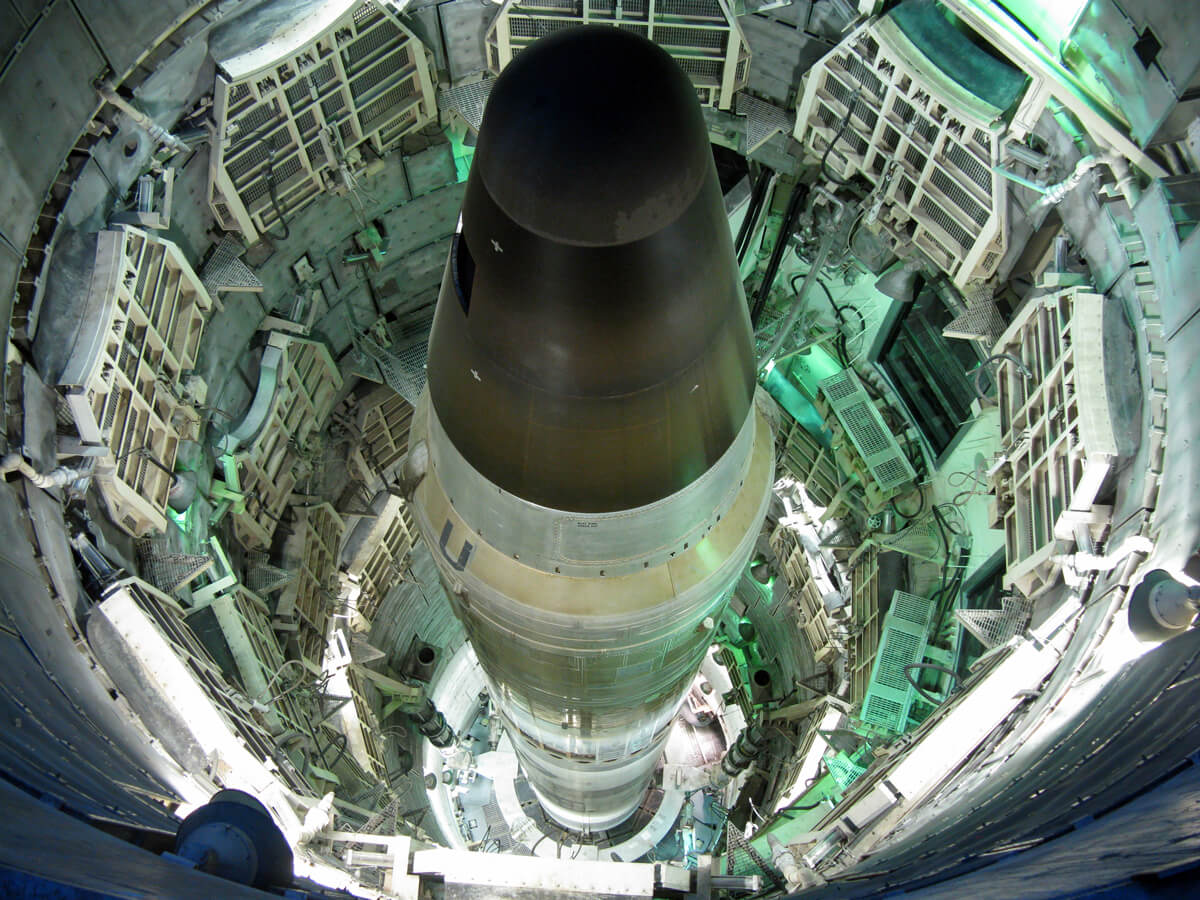 On June 3, 1980, at 3 a.m., National Security Advisor Zbigniew Brzezinski was awakened by a call from his military assistant. He was told that NORAD computers were reporting that 2,200 Soviet missiles had been launched against the United States. According to Brzezinski, just one minute before he planned to call President Jimmy Carter to recommend an immediate U.S. nuclear retaliatory response, word came through that the NORAD message was a false alarm caused by software simulating a Soviet missile attack that was inexplicably transferred into the live warning system at the command’s headquarters.
On June 3, 1980, at 3 a.m., National Security Advisor Zbigniew Brzezinski was awakened by a call from his military assistant. He was told that NORAD computers were reporting that 2,200 Soviet missiles had been launched against the United States. According to Brzezinski, just one minute before he planned to call President Jimmy Carter to recommend an immediate U.S. nuclear retaliatory response, word came through that the NORAD message was a false alarm caused by software simulating a Soviet missile attack that was inexplicably transferred into the live warning system at the command’s headquarters.





 As the head of the Organisation for the Prohibition of Nuclear Weapons (OPCW), Fernando Arias, noted in his opening statement, “The complete elimination of declared chemical weapons, which is a key goal of the convention, is nearing. Yet, challenges to the norms of the convention are serious, as the use of chemical weapons in Iraq, Malaysia, Syria, and the United Kingdom has proven.”
As the head of the Organisation for the Prohibition of Nuclear Weapons (OPCW), Fernando Arias, noted in his opening statement, “The complete elimination of declared chemical weapons, which is a key goal of the convention, is nearing. Yet, challenges to the norms of the convention are serious, as the use of chemical weapons in Iraq, Malaysia, Syria, and the United Kingdom has proven.” By the early 2000s, the ACWA Dialogue, including representatives from the Army, governors’ offices, and industry, along with grassroots activists, public health experts, and other interested stakeholders, recommended a wet chemistry option: neutralization, followed by bioremediation, supercritical water oxidation, and other technological processes.
By the early 2000s, the ACWA Dialogue, including representatives from the Army, governors’ offices, and industry, along with grassroots activists, public health experts, and other interested stakeholders, recommended a wet chemistry option: neutralization, followed by bioremediation, supercritical water oxidation, and other technological processes. The United States, in comparison, met its first two CWC benchmarks, primarily because of its early unilateral start, but also needed extensions under the CWC for its last two. The United States and Russia missed their final deadline of 2007 and the five-year extension, to 2012, but were given support by CWC states-parties for continuing with their best efforts beyond 2012.
The United States, in comparison, met its first two CWC benchmarks, primarily because of its early unilateral start, but also needed extensions under the CWC for its last two. The United States and Russia missed their final deadline of 2007 and the five-year extension, to 2012, but were given support by CWC states-parties for continuing with their best efforts beyond 2012.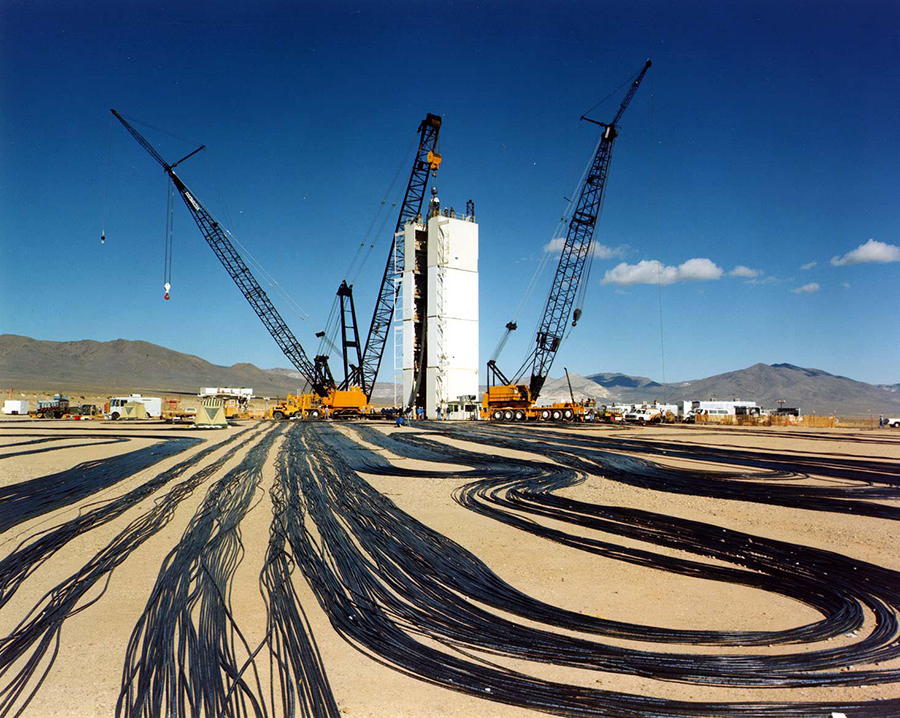 When U.S. President Bill Clinton took office in January 1993, one of the first issues he confronted was the future of U.S. nuclear testing. At the time, Congress was firmly in Democratic control, and the Democrats had been pressing the resistant Reagan and Bush administrations to agree to end U.S. nuclear testing if other countries, especially Russia, did as well.
When U.S. President Bill Clinton took office in January 1993, one of the first issues he confronted was the future of U.S. nuclear testing. At the time, Congress was firmly in Democratic control, and the Democrats had been pressing the resistant Reagan and Bush administrations to agree to end U.S. nuclear testing if other countries, especially Russia, did as well.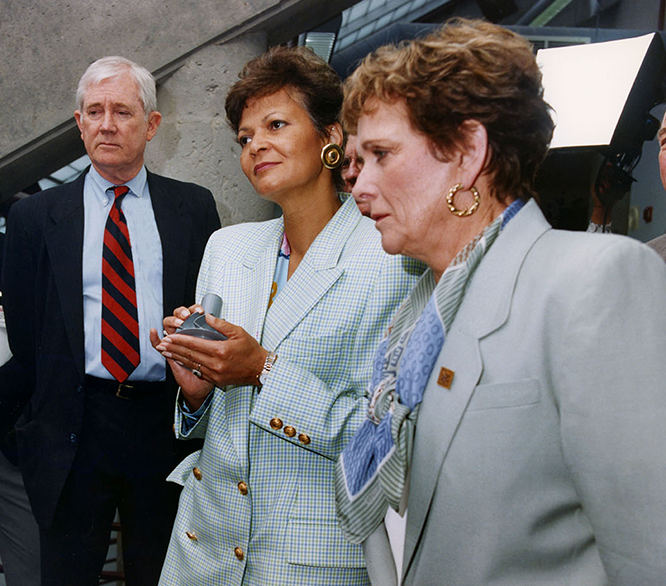 Despite the fact that the production and maintenance of nuclear weapons and the environmental cleanup of past plutonium production for weapons accounted for two-thirds of the Energy Department’s budget, O’Leary, like most of her predecessors, had no nuclear weapons background. She had a law degree and had been a prosecutor and an assistant attorney general in New Jersey. She moved to Washington and joined the Carter administration, ending up as administrator of the Economic Regulatory Administration within the Energy Department. During the Reagan administration, she served as executive vice president of Northern States Power, a public utility in Minnesota that operated a two-unit nuclear power plant. O’Leary is a black woman, and it was widely believed that one of the reasons that Clinton selected her as his energy secretary was because she increased the diversity of his cabinet.
Despite the fact that the production and maintenance of nuclear weapons and the environmental cleanup of past plutonium production for weapons accounted for two-thirds of the Energy Department’s budget, O’Leary, like most of her predecessors, had no nuclear weapons background. She had a law degree and had been a prosecutor and an assistant attorney general in New Jersey. She moved to Washington and joined the Carter administration, ending up as administrator of the Economic Regulatory Administration within the Energy Department. During the Reagan administration, she served as executive vice president of Northern States Power, a public utility in Minnesota that operated a two-unit nuclear power plant. O’Leary is a black woman, and it was widely believed that one of the reasons that Clinton selected her as his energy secretary was because she increased the diversity of his cabinet.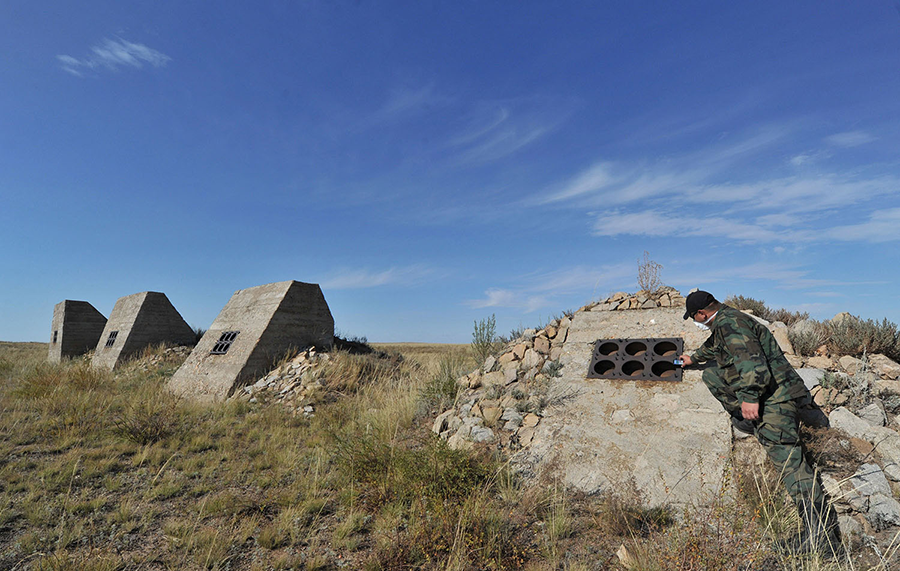 Reliable Replacement Warheads. One of the arguments the labs had made was that, despite the fact that a test ban had been a high-priority U.S. objective since the Eisenhower administration, U.S. warheads were so highly refined to have the highest possible yield-to-weight ratio that they could not be kept operational without testing. They argued that, in contrast, Russian warheads, with their lower yield-to-weight ratios, would fare better under a test ban. They therefore wanted to design Reliable Replacement Warheads whose designs would have larger “margins” between success and failure. This idea was pursued until 2008
Reliable Replacement Warheads. One of the arguments the labs had made was that, despite the fact that a test ban had been a high-priority U.S. objective since the Eisenhower administration, U.S. warheads were so highly refined to have the highest possible yield-to-weight ratio that they could not be kept operational without testing. They argued that, in contrast, Russian warheads, with their lower yield-to-weight ratios, would fare better under a test ban. They therefore wanted to design Reliable Replacement Warheads whose designs would have larger “margins” between success and failure. This idea was pursued until 2008
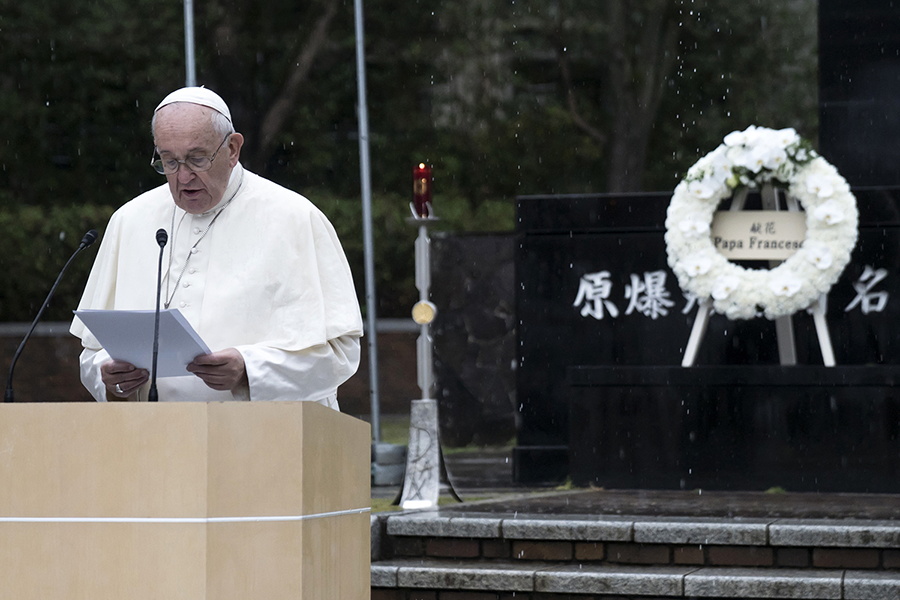 One of the deepest longings of the human heart is for security, peace and stability. The possession of nuclear and other weapons of mass destruction is not the answer to this desire. Indeed, they seem always to thwart it. Our world is marked by a perverse dichotomy that tries to defend and ensure stability and peace through a false sense of security sustained by a mentality of fear and mistrust, one that ends up poisoning relationships between peoples and obstructing any form of dialogue.
One of the deepest longings of the human heart is for security, peace and stability. The possession of nuclear and other weapons of mass destruction is not the answer to this desire. Indeed, they seem always to thwart it. Our world is marked by a perverse dichotomy that tries to defend and ensure stability and peace through a false sense of security sustained by a mentality of fear and mistrust, one that ends up poisoning relationships between peoples and obstructing any form of dialogue.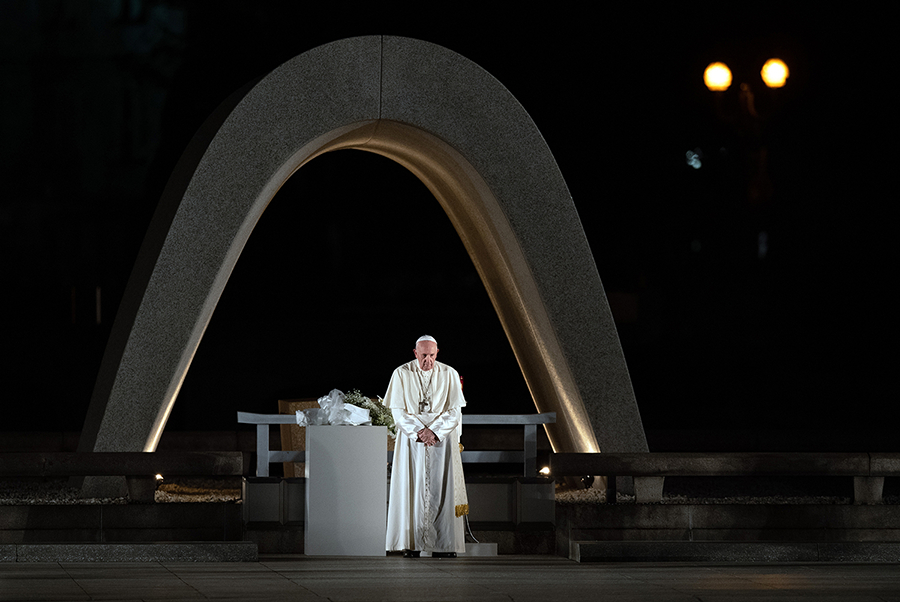 For her part, the Catholic Church is irrevocably committed to promoting peace between peoples and nations. This is a duty to which the Church feels bound before God and every man and woman in our world. We must never grow weary of working to support the principal international legal instruments of nuclear disarmament and non-proliferation, including the Treaty on the prohibition of nuclear weapons. Last July, the bishops of Japan launched an appeal for the abolition of nuclear arms, and each August the Church in Japan holds a 10-day prayer meeting for peace. May prayer, tireless work in support of agreements and insistence on dialogue be the most powerful “weapons” in which we put our trust and the inspiration of our efforts to build a world of justice and solidarity that can offer an authentic assurance of peace.
For her part, the Catholic Church is irrevocably committed to promoting peace between peoples and nations. This is a duty to which the Church feels bound before God and every man and woman in our world. We must never grow weary of working to support the principal international legal instruments of nuclear disarmament and non-proliferation, including the Treaty on the prohibition of nuclear weapons. Last July, the bishops of Japan launched an appeal for the abolition of nuclear arms, and each August the Church in Japan holds a 10-day prayer meeting for peace. May prayer, tireless work in support of agreements and insistence on dialogue be the most powerful “weapons” in which we put our trust and the inspiration of our efforts to build a world of justice and solidarity that can offer an authentic assurance of peace.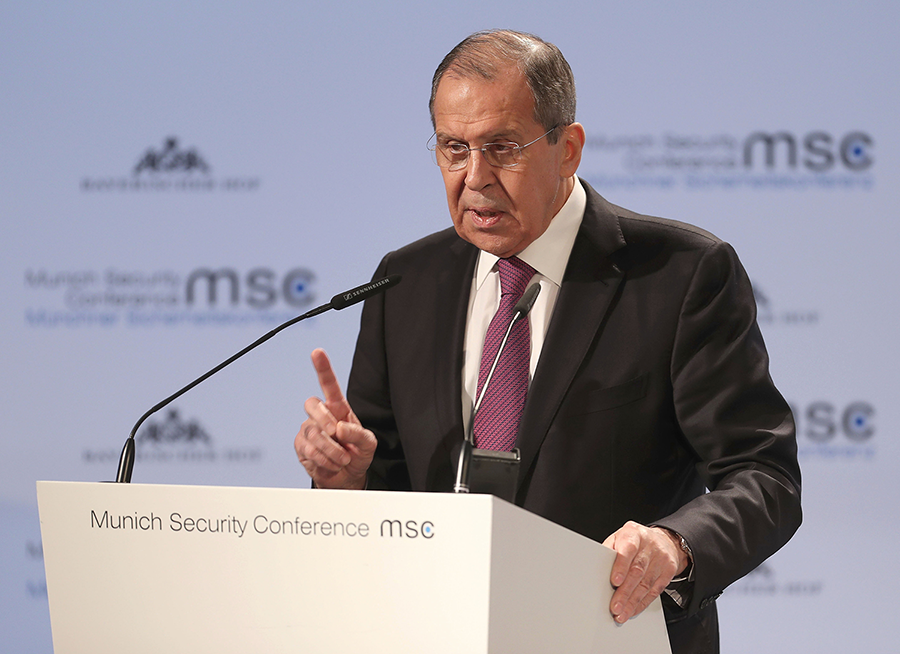 Washington “is evading any serious discussion, making public discouraging signals regarding the future of this treaty,” said Russian Foreign Minister Sergey Lavrov at a nonproliferation conference Nov. 8 in Moscow.
Washington “is evading any serious discussion, making public discouraging signals regarding the future of this treaty,” said Russian Foreign Minister Sergey Lavrov at a nonproliferation conference Nov. 8 in Moscow.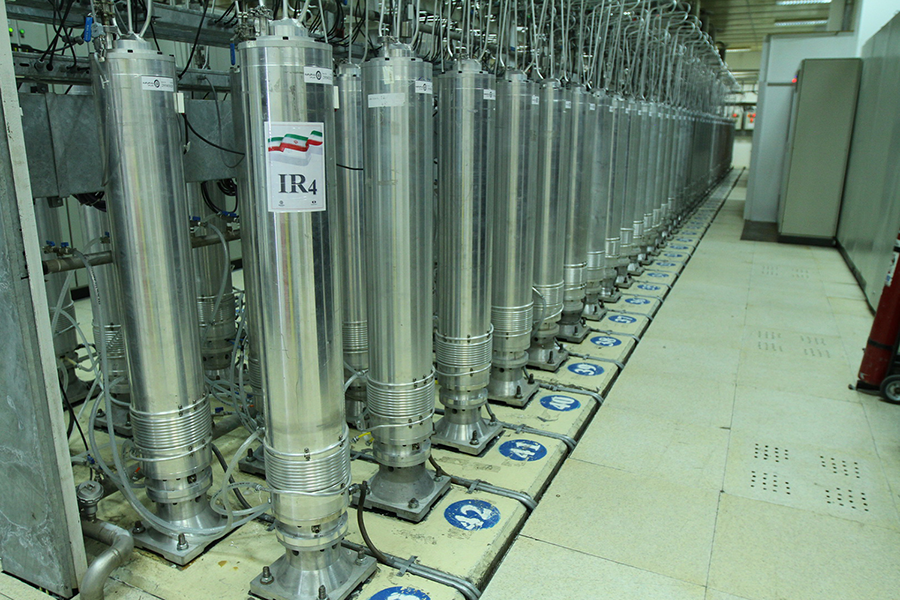 Iranian President Hassan Rouhani announced on Nov. 5 that Iran had “no other choice” but to resume enrichment at Fordow, violating the 15-year prohibition on enrichment at that site put in place by the Joint Comprehensive Plan of Action (JCPOA).
Iranian President Hassan Rouhani announced on Nov. 5 that Iran had “no other choice” but to resume enrichment at Fordow, violating the 15-year prohibition on enrichment at that site put in place by the Joint Comprehensive Plan of Action (JCPOA).
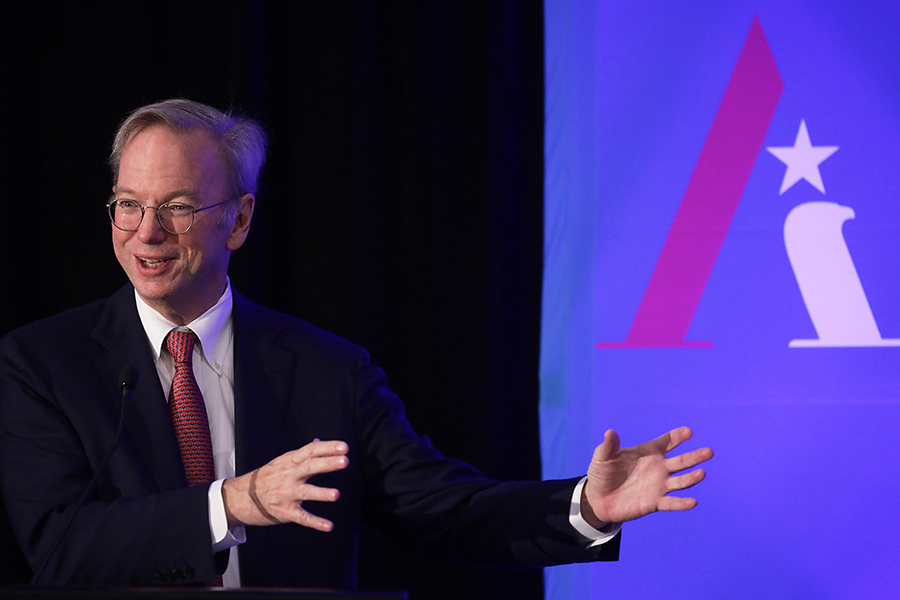 The DIB had originally been asked in 2018 to devise such recommendations by Defense Secretary Jim Mattis following a revolt by workers at Google over the company’s AI work for the department. Some 4,000 employees signed a petition calling on Google to discontinue its work on Project Maven, a pioneer Pentagon effort to employ AI in identifying suspected militants, possibly for elimination through drone attack. Google subsequently announced that it would not renew the Maven contract and promised never to develop AI for “weapons or other technologies whose principal purpose or implementation is to cause or directly facilitate injury to people.”
The DIB had originally been asked in 2018 to devise such recommendations by Defense Secretary Jim Mattis following a revolt by workers at Google over the company’s AI work for the department. Some 4,000 employees signed a petition calling on Google to discontinue its work on Project Maven, a pioneer Pentagon effort to employ AI in identifying suspected militants, possibly for elimination through drone attack. Google subsequently announced that it would not renew the Maven contract and promised never to develop AI for “weapons or other technologies whose principal purpose or implementation is to cause or directly facilitate injury to people.”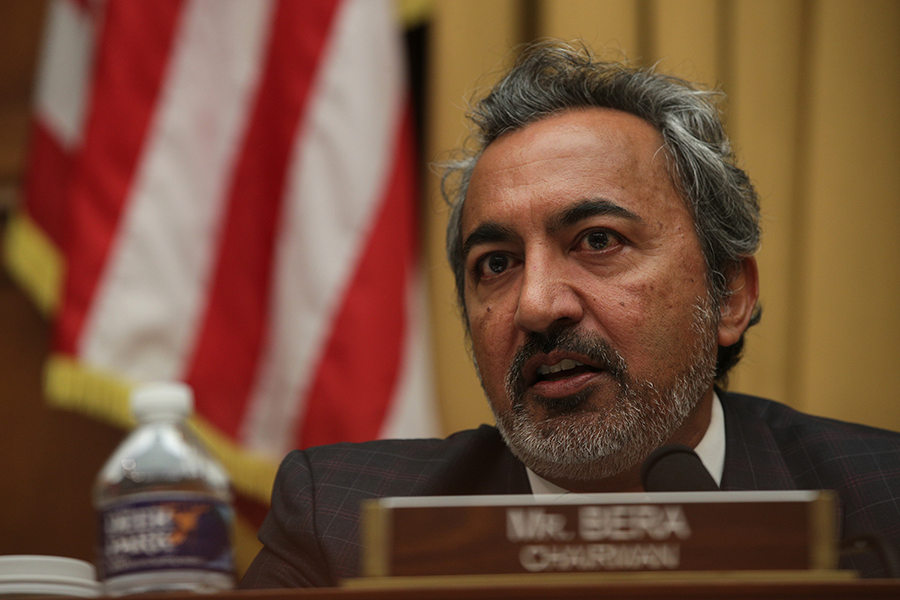 Under the proposed rules, semiautomatic and nonautomatic firearms and their ammunition, as well as certain other weapons, would be removed from the first three categories of the U.S. Munitions List (USML), a State Department-administered list of weapons. Sales of weapons from that list that meet certain dollar-value thresholds are notified to Congress, and a complex set of rules governs the reasons for which they may be transferred to and used by foreign recipients. Under the proposed changes, exports of these weapons would be transferred to a list administered by the Commerce Department, known as the Commerce Control List (CCL). The CCL does not trigger congressional notification requirements and allows for more streamlined arms transfer approvals.
Under the proposed rules, semiautomatic and nonautomatic firearms and their ammunition, as well as certain other weapons, would be removed from the first three categories of the U.S. Munitions List (USML), a State Department-administered list of weapons. Sales of weapons from that list that meet certain dollar-value thresholds are notified to Congress, and a complex set of rules governs the reasons for which they may be transferred to and used by foreign recipients. Under the proposed changes, exports of these weapons would be transferred to a list administered by the Commerce Department, known as the Commerce Control List (CCL). The CCL does not trigger congressional notification requirements and allows for more streamlined arms transfer approvals.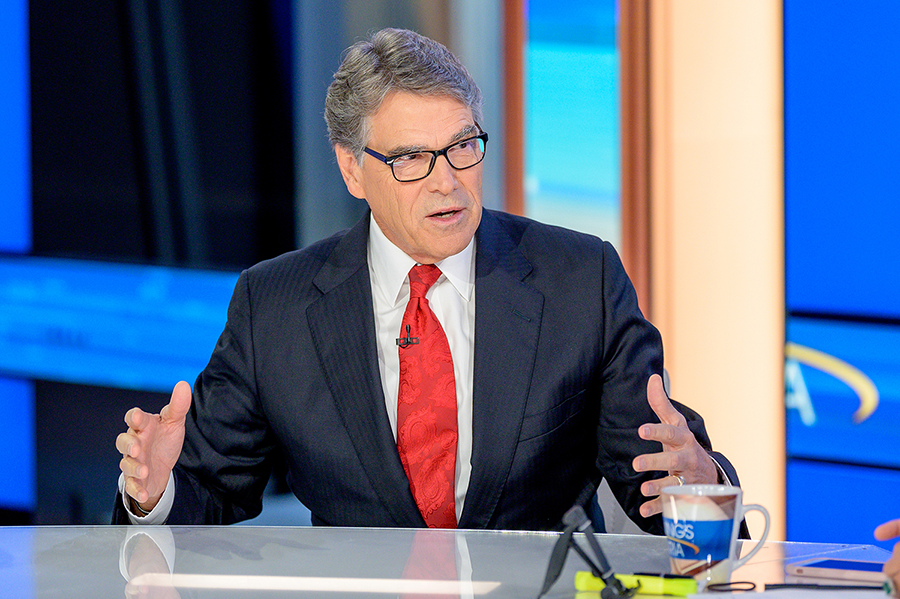 Saudi Arabia plans to build up its nuclear power program, but in order to receive U.S. nuclear materials or technology, Riyadh would need first to sign a 123 agreement with the United States. Such an agreement sets the terms and authorizes cooperation for sharing U.S. peaceful nuclear energy technology, equipment, and materials with other countries. A 123 agreement can involve what is known as a “gold standard” commitment in which a country forgoes uranium enrichment or plutonium reprocessing, which are two pathways to making nuclear weapons.
Saudi Arabia plans to build up its nuclear power program, but in order to receive U.S. nuclear materials or technology, Riyadh would need first to sign a 123 agreement with the United States. Such an agreement sets the terms and authorizes cooperation for sharing U.S. peaceful nuclear energy technology, equipment, and materials with other countries. A 123 agreement can involve what is known as a “gold standard” commitment in which a country forgoes uranium enrichment or plutonium reprocessing, which are two pathways to making nuclear weapons.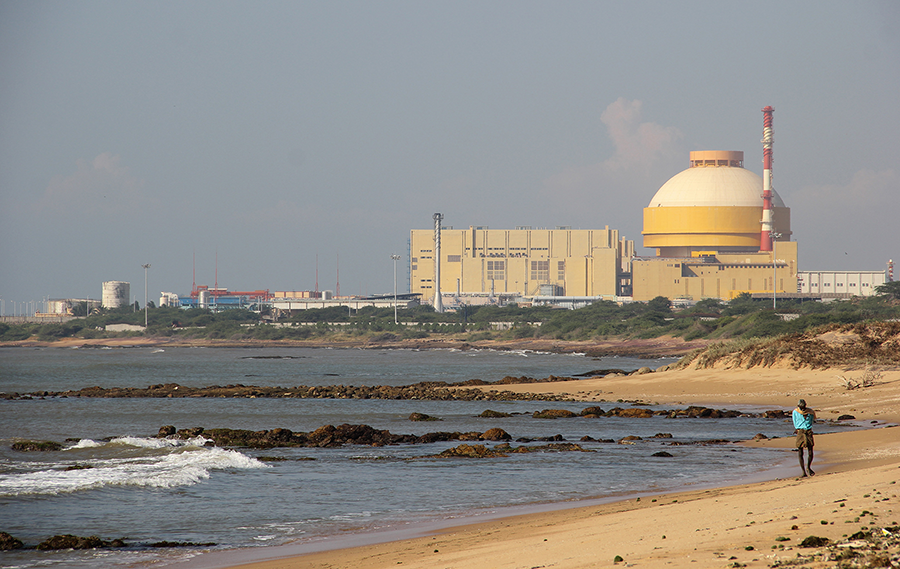 This came a day after the NPCIL released a statement denying an attack had occurred, stating that “any cyber-attack on the Nuclear Power Plant Control System is not possible.” Reports that Kudankulam had fallen victim to a cyberattack first surfaced on Twitter on Oct. 27.
This came a day after the NPCIL released a statement denying an attack had occurred, stating that “any cyber-attack on the Nuclear Power Plant Control System is not possible.” Reports that Kudankulam had fallen victim to a cyberattack first surfaced on Twitter on Oct. 27.